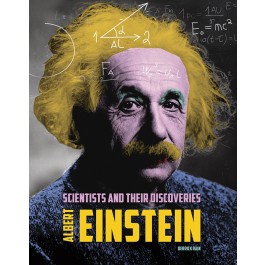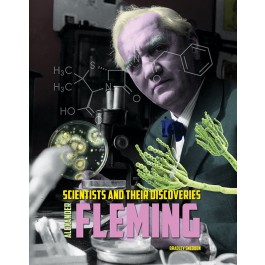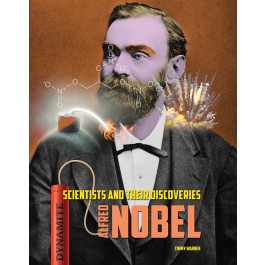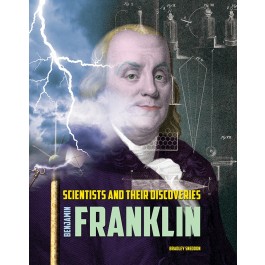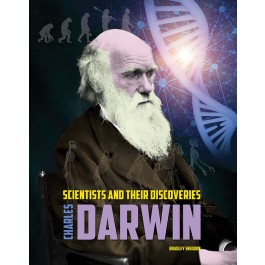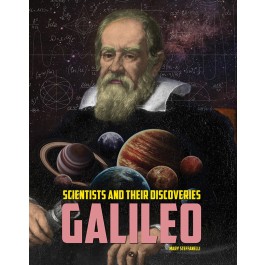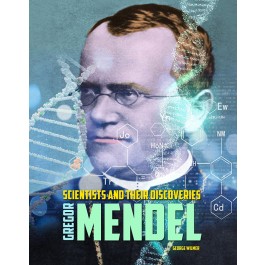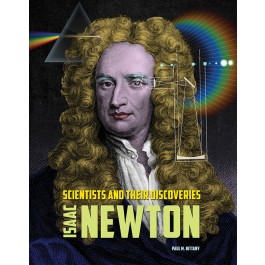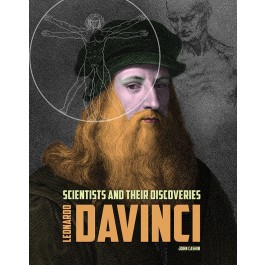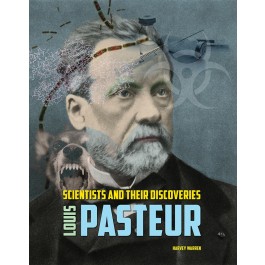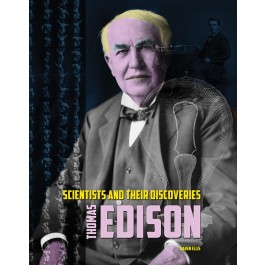SCIENTISTS AND THEIR DISCOVERIES

11
2019
12+
7th - 12th
7 x 9
by Derrick Rain
| Hardcover | ISBN 978-1-4222-4024-3 | $25.95 | Add To Cart |
| eBook | ISBN 978-1-4222-7756-0 | $32.95 | Add To Cart |
At the start of the twentieth century, an obscure German patent office clerk named Albert Einstein shocked the scientific world with his exciting discoveries in physics. His theories of special and general relativity forever changed the way that humans understand the workings of the universe. A true man of science, Einstein was also dedicated to helping causes he believed in. This book tells the story of Einstein’s life, covering not just his scientific discoveries but his work as an advocate as well. Each title in this series includes color photos throughout, and back matter including: an index and further reading lists for books and internet resources. Key Icons appear throughout the books in this series in an effort to encourage library readers to build knowledge, gain awareness, explore possibilities and expand their viewpoints through our content rich non-fiction books. Key Icons in this series are as follows: Words to Understand are shown at the front of each chapter with
definitions. These words are set in boldfaced type in that chapter, so that readers are able to reference back to the definitions--building their vocabulary and enhancing their reading comprehension. Sidebars are highlighted graphics with content rich material within that allows readers to build knowledge and broaden their perspectives by weaving together additional information to provide realistic and holistic perspectives. Educational Videos are offered in chapters through the use of a QR code, that, when scanned, takes the student to an online video showing a moment in history, a speech, or an instructional video. This gives the readers additional content to supplement the text. Text-Dependent Questions are placed at the end of each chapter. They challenge the reader’s comprehension of the chapter they have just read, while sending the reader back to the text for more careful attention to the evidence presented there. Research Projects are provided at the end of each chapter as well and provide readers with suggestions for projects that encourage deeper research and analysis. And a Series Glossary of Key Terms is included in the back matter containing terminology used throughout the series. Words found here broaden the reader’s knowledge and understanding of terms used in this field.
by Bradley Sneddon
| Hardcover | ISBN 978-1-4222-4025-0 | $25.95 | Add To Cart |
| eBook | ISBN 978-1-4222-7757-7 | $32.95 | Add To Cart |
One of the greatest medical discoveries of the modern age occurred when Doctor Alexander Fleming recognized that a certain type of mold prevented the growth of harmful bacteria. Fleming soon derived a substance from the mold called penicillin; it would be the first of many anti-bacterial drugs, and would save millions of lives during the Second World War. This book tells the story of Fleming’s discovery, as well as of his many other accomplishments during a lifetime of medical research. Each title in this series includes color photos throughout, and back matter including: an index and further reading lists for books and internet resources. Key Icons appear throughout the books in this series in an effort to encourage library readers to build knowledge, gain awareness, explore possibilities and expand their viewpoints through our content rich non-fiction books. Key Icons in this series are as follows: Words to Understand are shown at the front of each chapter with definitions. These
words are set in boldfaced type in that chapter, so that readers are able to reference back to the definitions--building their vocabulary and enhancing their reading comprehension. Sidebars are highlighted graphics with content rich material within that allows readers to build knowledge and broaden their perspectives by weaving together additional information to provide realistic and holistic perspectives. Educational Videos are offered in chapters through the use of a QR code, that, when scanned, takes the student to an online video showing a moment in history, a speech, or an instructional video. This gives the readers additional content to supplement the text. Text-Dependent Questions are placed at the end of each chapter. They challenge the reader’s comprehension of the chapter they have just read, while sending the reader back to the text for more careful attention to the evidence presented there. Research Projects are provided at the end of each chapter as well and provide readers with suggestions for projects that encourage deeper research and analysis. And a Series Glossary of Key Terms is included in the back matter containing terminology used throughout the series. Words found here broaden the reader’s knowledge and understanding of terms used in this field.
by Timmy Warner
| Hardcover | ISBN 978-1-4222-4026-7 | $25.95 | Add To Cart |
| eBook | ISBN 978-1-4222-7758-4 | $32.95 | Add To Cart |
The Swedish chemist and businessman Alfred Nobel made important discoveries in explosives, including the invention of dynamite in 1867. His products made it easier for workers to blast rock, drill tunnels, build canals, and perform many other types of construction work. After his death, Nobel dedicated most of his substantial estate for the establishment of the Nobel prizes, which are among the most prestigious awards given to scientists and peacemakers today. Each title in this series includes color photos throughout, and back matter including: an index and further reading lists for books and internet resources. Key Icons appear throughout the books in this series in an effort to encourage library readers to build knowledge, gain awareness, explore possibilities and expand their viewpoints through our content rich non-fiction books. Key Icons in this series are as follows: Words to Understand are shown at the front of each chapter with definitions. These words are set in boldfaced
type in that chapter, so that readers are able to reference back to the definitions--building their vocabulary and enhancing their reading comprehension. Sidebars are highlighted graphics with content rich material within that allows readers to build knowledge and broaden their perspectives by weaving together additional information to provide realistic and holistic perspectives. Educational Videos are offered in chapters through the use of a QR code, that, when scanned, takes the student to an online video showing a moment in history, a speech, or an instructional video. This gives the readers additional content to supplement the text. Text-Dependent Questions are placed at the end of each chapter. They challenge the reader’s comprehension of the chapter they have just read, while sending the reader back to the text for more careful attention to the evidence presented there. Research Projects are provided at the end of each chapter as well and provide readers with suggestions for projects that encourage deeper research and analysis. And a Series Glossary of Key Terms is included in the back matter containing terminology used throughout the series. Words found here broaden the reader’s knowledge and understanding of terms used in this field.
by Bradley Sneddon
| Hardcover | ISBN 978-1-4222-4027-4 | $25.95 | Add To Cart |
| eBook | ISBN 978-1-4222-7759-1 | $32.95 | Add To Cart |
Benjamin Franklin’s life was remarkable. From humble origins, he rose to become one of the most well-known and popular figures in North America and Europe during the eighteenth century. During his life Franklin developed an extraordinary range of interests. His contributions to science include major discoveries in electricity and oceanography, but his activities as a businessman, publisher and writer, philosopher, and statesman are equally important to produce a complete picture of his life. Each title in this series includes color photos throughout, and back matter including: an index and further reading lists for books and internet resources. Key Icons appear throughout the books in this series in an effort to encourage library readers to build knowledge, gain awareness, explore possibilities and expand their viewpoints through our content rich non-fiction books. Key Icons in this series are as follows: Words to Understand are shown at the front of each chapter with definitions.
These words are set in boldfaced type in that chapter, so that readers are able to reference back to the definitions--building their vocabulary and enhancing their reading comprehension. Sidebars are highlighted graphics with content rich material within that allows readers to build knowledge and broaden their perspectives by weaving together additional information to provide realistic and holistic perspectives. Educational Videos are offered in chapters through the use of a QR code, that, when scanned, takes the student to an online video showing a moment in history, a speech, or an instructional video. This gives the readers additional content to supplement the text. Text-Dependent Questions are placed at the end of each chapter. They challenge the reader’s comprehension of the chapter they have just read, while sending the reader back to the text for more careful attention to the evidence presented there. Research Projects are provided at the end of each chapter as well and provide readers with suggestions for projects that encourage deeper research and analysis. And a Series Glossary of Key Terms is included in the back matter containing terminology used throughout the series. Words found here broaden the reader’s knowledge and understanding of terms used in this field.
by Bradley Sneddon
| Hardcover | ISBN 978-1-4222-4028-1 | $25.95 | Add To Cart |
| eBook | ISBN 978-1-4222-7760-7 | $32.95 | Add To Cart |
In 1831, at the age of twenty-two, Charles Darwin embarked on a momentous five-year-long voyage on the HMS Beagle. His observations during this voyage led Darwin to eventually conclude that all species of plant and animal life have slowly evolved over thousands of years, adapting themselves to their environment by a process of natural selection. This book tells the story of Darwin’s life, detailing the findings and events that led him to develop his groundbreaking and controversial ideas on biology and geology. Each title in this series includes color photos throughout, and back matter including: an index and further reading lists for books and internet resources. Key Icons appear throughout the books in this series in an effort to encourage library readers to build knowledge, gain awareness, explore possibilities and expand their viewpoints through our content rich non-fiction books. Key Icons in this series are as follows: Words to Understand are shown at the front of each chapter
with definitions. These words are set in boldfaced type in that chapter, so that readers are able to reference back to the definitions--building their vocabulary and enhancing their reading comprehension. Sidebars are highlighted graphics with content rich material within that allows readers to build knowledge and broaden their perspectives by weaving together additional information to provide realistic and holistic perspectives. Educational Videos are offered in chapters through the use of a QR code, that, when scanned, takes the student to an online video showing a moment in history, a speech, or an instructional video. This gives the readers additional content to supplement the text. Text-Dependent Questions are placed at the end of each chapter. They challenge the reader’s comprehension of the chapter they have just read, while sending the reader back to the text for more careful attention to the evidence presented there. Research Projects are provided at the end of each chapter as well and provide readers with suggestions for projects that encourage deeper research and analysis. And a Series Glossary of Key Terms is included in the back matter containing terminology used throughout the series. Words found here broaden the reader’s knowledge and understanding of terms used in this field.
by Mary Steffanelli
| Hardcover | ISBN 978-1-4222-4029-8 | $25.95 | Add To Cart |
| eBook | ISBN 978-1-4222-7761-4 | $32.95 | Add To Cart |
The Italian scientist Galileo Galilei is remembered today as a genius who, in the early seventeenth century, produced revolutionary developments and innovations in astronomy and physics that contributed greatly to the human understanding of how the world works. However, during his lifetime Galileo suffered persecution because his ideas were offensive to the religious leaders of his times. This book tells the story of Galileo’s life, as well as the development and influence of his scientific work. Each title in this series includes color photos throughout, and back matter including: an index and further reading lists for books and internet resources. Key Icons appear throughout the books in this series in an effort to encourage library readers to build knowledge, gain awareness, explore possibilities and expand their viewpoints through our content rich non-fiction books. Key Icons in this series are as follows: Words to Understand are shown at the front of each chapter with
definitions. These words are set in boldfaced type in that chapter, so that readers are able to reference back to the definitions--building their vocabulary and enhancing their reading comprehension. Sidebars are highlighted graphics with content rich material within that allows readers to build knowledge and broaden their perspectives by weaving together additional information to provide realistic and holistic perspectives. Educational Videos are offered in chapters through the use of a QR code, that, when scanned, takes the student to an online video showing a moment in history, a speech, or an instructional video. This gives the readers additional content to supplement the text. Text-Dependent Questions are placed at the end of each chapter. They challenge the reader’s comprehension of the chapter they have just read, while sending the reader back to the text for more careful attention to the evidence presented there. Research Projects are provided at the end of each chapter as well and provide readers with suggestions for projects that encourage deeper research and analysis. And a Series Glossary of Key Terms is included in the back matter containing terminology used throughout the series. Words found here broaden the reader’s knowledge and understanding of terms used in this field.
by George Wilmer
| Hardcover | ISBN 978-1-4222-4030-4 | $25.95 | Add To Cart |
| eBook | ISBN 978-1-4222-7762-1 | $32.95 | Add To Cart |
During the nineteenth century, an Austrian friar named Gregor Mendel discovered that invisible factors, now called genes, determined the traits of an organism. Mendel found that certain traits passed down from parents were either dominant or recessive, and that patterns of trait inheritance could be reliably predicted. His work was little noticed until the early twentieth century, when other scientists, working independently, replicated his work. Mendel’s life and accomplishments are detailed in this book. Each title in this series includes color photos throughout, and back matter including: an index and further reading lists for books and internet resources. Key Icons appear throughout the books in this series in an effort to encourage library readers to build knowledge, gain awareness, explore possibilities and expand their viewpoints through our content rich non-fiction books. Key Icons in this series are as follows: Words to Understand are shown at the front of each chapter with
definitions. These words are set in boldfaced type in that chapter, so that readers are able to reference back to the definitions--building their vocabulary and enhancing their reading comprehension. Sidebars are highlighted graphics with content rich material within that allows readers to build knowledge and broaden their perspectives by weaving together additional information to provide realistic and holistic perspectives. Educational Videos are offered in chapters through the use of a QR code, that, when scanned, takes the student to an online video showing a moment in history, a speech, or an instructional video. This gives the readers additional content to supplement the text. Text-Dependent Questions are placed at the end of each chapter. They challenge the reader’s comprehension of the chapter they have just read, while sending the reader back to the text for more careful attention to the evidence presented there. Research Projects are provided at the end of each chapter as well and provide readers with suggestions for projects that encourage deeper research and analysis. And a Series Glossary of Key Terms is included in the back matter containing terminology used throughout the series. Words found here broaden the reader’s knowledge and understanding of terms used in this field.
by Paul M. Nittany
| Hardcover | ISBN 978-1-4222-4031-1 | $25.95 | Add To Cart |
| eBook | ISBN 978-1-4222-7763-8 | $32.95 | Add To Cart |
The universal law of gravitation developed by Isaac Newton was one of the most amazing scientific discoveries of modern times. His theories about the universe, published in 1687, would help humans to better understand how the world works. Newton’s revolutionary method of mathematical calculation, which he called calculus, made many subsequent major scientific discoveries possible. This book tells the story of Newton’s scientific discoveries in many fields. Each title in this series includes color photos throughout, and back matter including: an index and further reading lists for books and internet resources. Key Icons appear throughout the books in this series in an effort to encourage library readers to build knowledge, gain awareness, explore possibilities and expand their viewpoints through our content rich non-fiction books. Key Icons in this series are as follows: Words to Understand are shown at the front of each chapter with definitions. These words are set in boldfaced
type in that chapter, so that readers are able to reference back to the definitions--building their vocabulary and enhancing their reading comprehension. Sidebars are highlighted graphics with content rich material within that allows readers to build knowledge and broaden their perspectives by weaving together additional information to provide realistic and holistic perspectives. Educational Videos are offered in chapters through the use of a QR code, that, when scanned, takes the student to an online video showing a moment in history, a speech, or an instructional video. This gives the readers additional content to supplement the text. Text-Dependent Questions are placed at the end of each chapter. They challenge the reader’s comprehension of the chapter they have just read, while sending the reader back to the text for more careful attention to the evidence presented there. Research Projects are provided at the end of each chapter as well and provide readers with suggestions for projects that encourage deeper research and analysis. And a Series Glossary of Key Terms is included in the back matter containing terminology used throughout the series. Words found here broaden the reader’s knowledge and understanding of terms used in this field.
by John Cashin
| Hardcover | ISBN 978-1-4222-4032-8 | $25.95 | Add To Cart |
| eBook | ISBN 978-1-4222-7764-5 | $32.95 | Add To Cart |
Leonardo da Vinci was a great painter of the Italian Renaissance period, known for such iconic works as the Mona Lisa portrait and the Last Supper fresco. Yet Leonardo was a true Renaissance Man, who made important contributions to human knowledge as a scientist and inventor. He conducted numerous carefully planned experiments, and produced extensive drawings and notes on human anatomy, as well as on fantastic inventions. Leonardo’s rich life and numerous accomplishments are detailed in this book. Each title in this series includes color photos throughout, and back matter including: an index and further reading lists for books and internet resources. Key Icons appear throughout the books in this series in an effort to encourage library readers to build knowledge, gain awareness, explore possibilities and expand their viewpoints through our content rich non-fiction books. Key Icons in this series are as follows: Words to Understand are shown at the front of each chapter with
definitions. These words are set in boldfaced type in that chapter, so that readers are able to reference back to the definitions--building their vocabulary and enhancing their reading comprehension. Sidebars are highlighted graphics with content rich material within that allows readers to build knowledge and broaden their perspectives by weaving together additional information to provide realistic and holistic perspectives. Educational Videos are offered in chapters through the use of a QR code, that, when scanned, takes the student to an online video showing a moment in history, a speech, or an instructional video. This gives the readers additional content to supplement the text. Text-Dependent Questions are placed at the end of each chapter. They challenge the reader’s comprehension of the chapter they have just read, while sending the reader back to the text for more careful attention to the evidence presented there. Research Projects are provided at the end of each chapter as well and provide readers with suggestions for projects that encourage deeper research and analysis. And a Series Glossary of Key Terms is included in the back matter containing terminology used throughout the series. Words found here broaden the reader’s knowledge and understanding of terms used in this field.
by Harvey Warren
| Hardcover | ISBN 978-1-4222-4033-5 | $25.95 | Add To Cart |
| eBook | ISBN 978-1-4222-7765-2 | $32.95 | Add To Cart |
The French scientist Louis Pasteur made important contributions to chemistry and microbiology. His studies of microbes, which he called germs, helped people to understand the cause of decay in food. Pasteur made important contributions to the alcohol and silk industries, but he is perhaps best known for creating lifesaving vaccines against deadly illnesses, including anthrax, cholera, and rabies. This biography explains Pasteur’s many contributions to science during the nineteenth century. Each title in this series includes color photos throughout, and back matter including: an index and further reading lists for books and internet resources. Key Icons appear throughout the books in this series in an effort to encourage library readers to build knowledge, gain awareness, explore possibilities and expand their viewpoints through our content rich non-fiction books. Key Icons in this series are as follows: Words to Understand are shown at the front of each chapter with definitions.
These words are set in boldfaced type in that chapter, so that readers are able to reference back to the definitions--building their vocabulary and enhancing their reading comprehension. Sidebars are highlighted graphics with content rich material within that allows readers to build knowledge and broaden their perspectives by weaving together additional information to provide realistic and holistic perspectives. Educational Videos are offered in chapters through the use of a QR code, that, when scanned, takes the student to an online video showing a moment in history, a speech, or an instructional video. This gives the readers additional content to supplement the text. Text-Dependent Questions are placed at the end of each chapter. They challenge the reader’s comprehension of the chapter they have just read, while sending the reader back to the text for more careful attention to the evidence presented there. Research Projects are provided at the end of each chapter as well and provide readers with suggestions for projects that encourage deeper research and analysis. And a Series Glossary of Key Terms is included in the back matter containing terminology used throughout the series. Words found here broaden the reader’s knowledge and understanding of terms used in this field.
by Karen Ellis
| Hardcover | ISBN 978-1-4222-4034-2 | $25.95 | Add To Cart |
| eBook | ISBN 978-1-4222-7766-9 | $32.95 | Add To Cart |
Thomas Alva Edison was one of the most creative inventors in the history of mankind. His inventions—including systems for electric lighting, improvements to communication technology, and devices for recording and replaying sounds and movies—shaped the modern world. A tireless worker who often spent up to twenty hours a day at work, he made invention a commercial proposition, setting up the world’s first industrial research laboratory. This book describes Edison’s accomplishments and his legacy. Each title in this series includes color photos throughout, and back matter including: an index and further reading lists for books and internet resources. Key Icons appear throughout the books in this series in an effort to encourage library readers to build knowledge, gain awareness, explore possibilities and expand their viewpoints through our content rich non-fiction books. Key Icons in this series are as follows: Words to Understand are shown at the front of each chapter with
definitions. These words are set in boldfaced type in that chapter, so that readers are able to reference back to the definitions--building their vocabulary and enhancing their reading comprehension. Sidebars are highlighted graphics with content rich material within that allows readers to build knowledge and broaden their perspectives by weaving together additional information to provide realistic and holistic perspectives. Educational Videos are offered in chapters through the use of a QR code, that, when scanned, takes the student to an online video showing a moment in history, a speech, or an instructional video. This gives the readers additional content to supplement the text. Text-Dependent Questions are placed at the end of each chapter. They challenge the reader’s comprehension of the chapter they have just read, while sending the reader back to the text for more careful attention to the evidence presented there. Research Projects are provided at the end of each chapter as well and provide readers with suggestions for projects that encourage deeper research and analysis. And a Series Glossary of Key Terms is included in the back matter containing terminology used throughout the series. Words found here broaden the reader’s knowledge and understanding of terms used in this field.











